What if the Bee had an S?
What would it be like if the #nytspellingbee had an S in it?
@thegridkid is on record as saying an S-Bee would be “too easy,” a nice way of saying it’s difficult to balance difficulty, size, and funness. I wanted a sense of this design space, so I did some computer’ing.
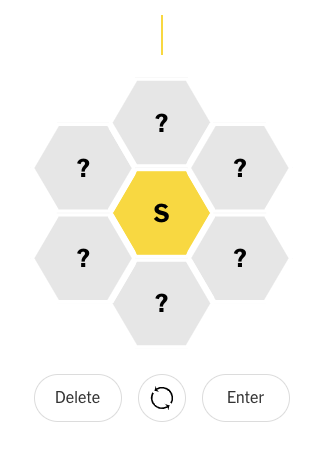
A quick review: The NYTimes Spelling Bee is a word game where you find as many words as you can that can be spelled with a given 7 letters. Letters can be repeated. One letter is required to appear at least once in all answers, and all answers are at least four letters long.
The Bee can be played on your phone or in a browser, with a new puzzle each day. The game recognizes only a subset of all possible words, excluding obscure or offensive terms. You might disagree with the choices, but they’re always well intentioned.nytimes.com/puzzles/spelli…
Every puzzle contains at least one pangram, a word that uses all seven letters. A “perfect” pangram is seven letters long, but this is not required. A “bingo” puzzle has at least one word that starts with each letter, but this also is not required.
Notice that two puzzles can share the same pangrams and still be different puzzles based on which letter is marked as required. nytbee.com collects stats on Bee puzzles, and highlights when pangrams have reappeared in the Bee.
Word forms, prefixes, and suffixes play a big role in answer sets. If you’ve got a D and an E, it’s likely verbs will appear as both present tense (“appear”) and past tense (“appeared”). If the D is required, maybe only the past tense form is an answer.
A puzzle with an S in it could be a problem: it potentially blows out the answer list to include many plural forms. A Bee with a large answer set is not as fun as it sounds! Some players try to find all of the word list, and this can easily become a chore.
A short answer list is also potentially unfun. Moreover, the pangram should be satisfying to find, a word that most people know. Not every seven letter combo makes a good puzzle, and fun Bees are an art. That’s why the NYTimes has a puzzle editor.
To explore possible S-Bees, I decided to only consider puzzles where S was the required letter. The search space is larger when it’s not required, but I didn’t expect to learn anything from it. I just want to know if there are fun puzzles with an S.
Next I had to pick a dictionary. I started with the canonical “words” file that comes with any Mac or Linux computer. It contains 235,886 words, but it turns out that it does not contain simple plurals! This defeats the purpose of the S-Bee inquiry.
The North American Scrabble Players Association (NASPA) maintains a word list for tournaments, a superset of the official Scrabble Dictionary. TWL06 is easy to find online, with 178,690 words and good plural coverage. Plenty good enough for my purposes.
I wrote a Python script that takes a dictionary and generates Bee puzzles with a given required letter. It takes about 6 minutes 30 seconds on my laptop to find every S-Bee.gist.github.com/dansanderson/f…
Then I started asking questions about Bee size—that is, the size of the answer list—as the first hint of “fun.” The largest S-Bee is [S]AEINRT at 1203 words, with 98 pangrams including NASTIER, ANTISTRESS, TRAINERS, RESTRAIN. Also some odd plurals like IRATENESSES.
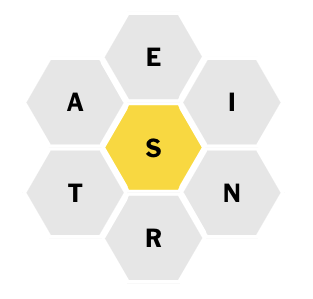
We could eliminate obscure simple plurals, but that’s a potential problem for S-Bees: if we eliminate a simple plural as obscure (IRATENESSES), do we also eliminate the singular (IRATENESS) when both are present? Do we decide on “obscure plural” style rules (no -NESSES)?
The smallest S-Bee in TWL06 is [S]HKOVYZ at 20 words. Solve it if you dare, but here’s a hint: the sole pangram is a loanword plural that does not end in S. The word is probably too obscure for the Bee and thus eliminates the whole puzzle. (It’s a new word to me, fwiw.)
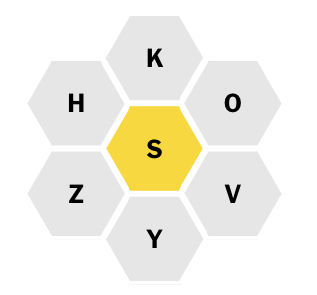
The distribution of S-Bee sizes shows the mass of puzzles with many hundreds of words. If we say a good Bee size is around 25-50 words and we’re likely to eliminate 20-30 due to obscurity, the raw S-Bees in the 45-80 range on the left edge are worth a closer look.
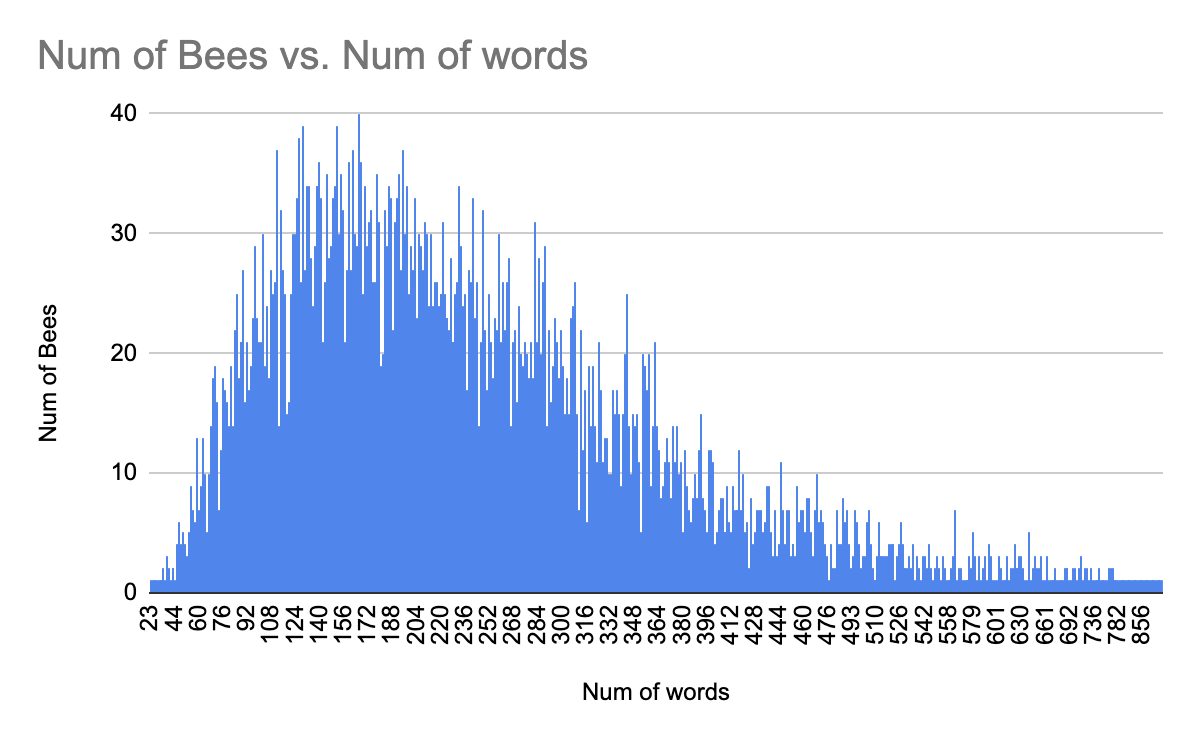
The most common word count for S-Bees is 166 words, with 40 S-Bees having this count. I don’t know what to do with this information.
Let’s try designing an S-Bee puzzle, starting with a raw S-Bee of 60 words. There are 7 possibilities: [S]ADIRVZ, [S]BEIQUZ, [S]BIKOUZ, [S]CHKMNU, [S]FGINUX, [S]GHIORV, [S]INQTUY. Look at all those chonky rares balancing out the word count!
The pangrams are not looking good. SQUINTY and SUFFIXING are least bad. NUMCHUCKS is an alternate spelling for “nunchucks” that I didn’t know and would probably anger some players if it were the sole pangram. VIGORISH, VIZARDS, BEZIQUES, BOUZOUKIS. 😬
SQUINTY is tempting for almost being a word I’d use, and for not being a plural. I’m not sure how I’d feel if I saw a Q in an actual Bee. I can define 39/60 of the answer list using my own illiterate memory. Actual Bees tend to push my vocab a bit.

Expert players might like the whole 60-word list. Do your eyes SQUINNY in the sun? How many Peruvian INTIS did a good dictionary cost? How strong is my NISUS to find a good S-Bee? Need some YINS for your yangs?
I won’t post the whole word list if you want to try it. There’s some satisfying solve in there. Here’s a hint chart for the 39 words I know off the top of my head (not including SQUINNY, INTIS, NISUS, or YINS).
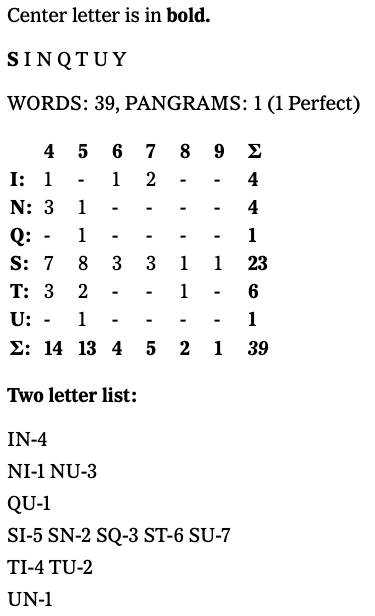
Skimming just the pangrams of S-Bees sized 55-65, I see a few fun ones: [S]BCGORY, [S]BFNOUX, [S]GIORUV, [S]ILORUX, [S]FHILUW, [S]ADGKOZ (!), [S]CDIJOU, [S]BILTVY, [S]CIOTVY. I find I’m more attracted to pangrams that are not plurals or pluralizable.
A quick peek at the word list for [S]ADGKOZ using the “do I know this word?” test does not fare well. I also notice that most of the words are short plural nouns whose singulars don’t contain S (ados, gags, oaks, zoos), which just doesn’t make me feel clever at all as a player.
I don’t think I’ve demonstrated that there are fun S-Bees that would meet NYTimes standards, but there are definitely quite a few to consider. I would want to run them by test players to be sure.
Happy hunting, #hivemind! 🐝
(Originally posted to Twitter on December 12, 2021. It received 25 likes.)